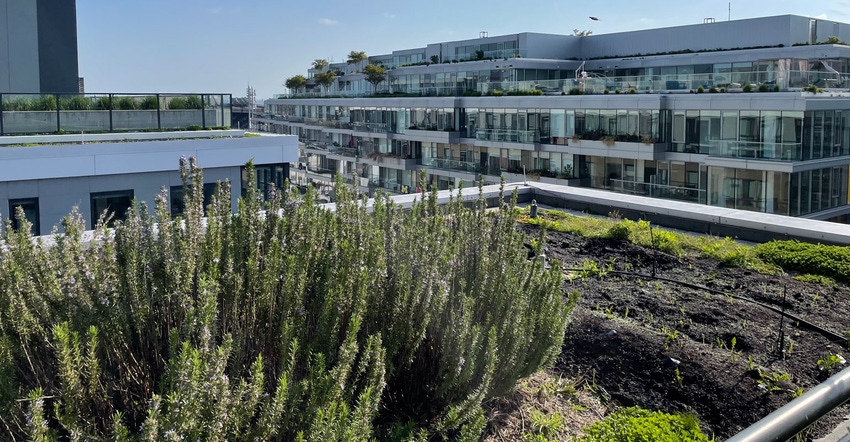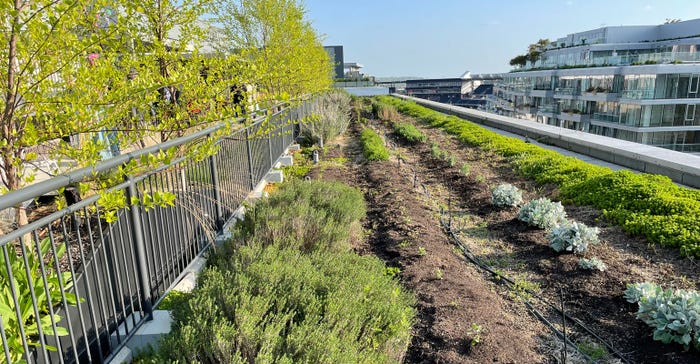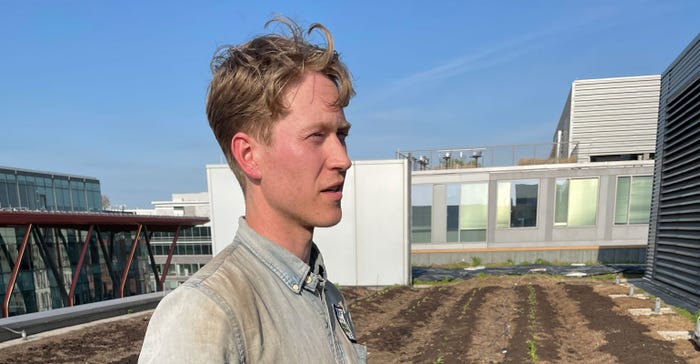
Farming is already challenging enough. Now imagine farming on a roof in the middle of the city — no soil, no tractors, no easy transport.
Kristof Grina, one of the founders of Up Top Acres in Washington, D.C., knows that rooftop farming isn’t for everyone, but in the middle of the nation’s capital, it’s a great way to educate and teach about agriculture.
“I'm under no false pretenses that we're going to be able to feed a large portion of the population by doing this, but I do think it's very valuable to help to bring people up here and help sort of talk to them about issues in agriculture,” says Grina, who co-founded Up Top Acres in 2014 with two partners.
The organization farms 18 different rooftops in Washington, ranging from 1,000 square feet to 1 acre in size. All told, they manage 3 acres of rooftop farms in the city through contracts with building owners who help subsidize the organization’s operating costs.
Strict stormwater management regulations mean that every new building in the city must capture a certain amount of stormwater to comply with Chesapeake Bay nutrient management rules. Green roofs are a good way of doing this, but rooftop farms can take it to another level, along with providing building tenants with some fresh produce.
"And so basically, we're telling buildings, you're already installing [a green roof] or … it's already been installed, and you’re paying to maintain it and it's being maintained poorly,” Grina says. “We can enhance it, we can add another layer, another function to it, and have it still perform the tasks that it was doing before.
“The name of the game in stormwater management is basically trying to slow down the water right when it rains. And so this roof absorbs a lot of water, but it doesn't release all the rain in a large stormwater event. But what it does is it slows it down and releases it gradually to help deal with the inundation and give the sewers the ability to handle it.”
They also work on existing buildings in various types of setups, including raised bed projects and even greenhouses. “We have a lot of different systems and a lot of methods to make it work on, whatever rooftop there is,” Grina says.
Adjusting goals
Grina and his two co-founders modeled Up Top Acres after another well-known rooftop farming organization in the Northeast, Brooklyn Grange, and adapted it to Washington.
“It’s a much different real estate market here, so we had to modify it,” he says. “There are much larger building plates there. They have roofs that are almost 3 acres just stand-alone. There aren’t really any buildings in D.C. that fit that. Everything is a little bigger in New York.”
Up Top’s original model was a community-supported agriculture venture and was selling to farmers markets, but the logistics of doing a CSA and transporting products from roof to ground level proved too difficult.
“All the challenges you face at ground level are two to three to four times that when you’re farming in the sky, on a rooftop,” Grina says. “We can’t get to the economies of scale; we have trouble with logistics. Everything goes up a loading elevator, goes down the loading elevator. We have to aggregate from 18 different sites, and these challenges can be a logistical nightmare, so that means labor costs go up.”

MANAGING RUNOFF: Strict stormwater management regulations mean that every new building in Washington, D.C., must capture a certain amount of stormwater to comply with Chesapeake Bay nutrient management rules. Green roofs are a good way of doing this, but rooftop farms can take it to another level — along with providing building tenants with some fresh produce.
Each site at Up Top Acres is unique. For example, The Farm at 55M is 18,000 square feet with sweet peppers, Swiss chard, kale, cut flowers, tomatoes, watermelons, perennial herbs and more. It is also an events space. Other rooftop projects are more small garden spaces, and at least one works directly with an award-winning restaurant in the city.
The organization grows 25 different small fruits and vegetables, and 15 different varieties of cut flowers and herbs on its rooftops.
Setting the foundation
The organization buys a proprietary “growing medium” to establish growing beds on each rooftop. Grina says the soil formulation is designed to be lightweight, sufficient in organic matter and quick-draining to deal with heavy rains.
“It is designed to hold water well up until the point of saturation, and then once it gets to that point, it will shed that water efficiently,” he says.
Once the soil is put down — about 12 inches of it — a soil test is done, and based on that test, they will topdress with compost.

TEACHING AG: Kristof Grina, one of the founders of Up Top Acres in Washington, D.C., knows that rooftop farming isn’t for everyone, but in the middle of the nation’s capital, it’s a great way to educate and teach about agriculture.
Each rooftop has its own microclimate, Grina says, so that affects what crops are grown. One thing that’s consistent across all the rooftops is high wind, so he and his employees select plants that grow low to the ground — tomatoes, for example, are dwarf varieties.
All beds are no-till. None of the rooftops are certified organic, but Grina says they follow organic principles. Cover crops, usually a vetch and clover mix, are planted to help control weeds and keep the soil in place.
Tarping is used to control weeds, along with some hand cultivation.
Plants are usually started in flats indoors and then transplanted in early spring. Washington typically has mild springs and falls, and with the abundant sunshine on the rooftops, Grina says the typical growing season goes from early April to mid-November.
Bugs are an issue, too, but more of the flying or winged variety. “Birds, crows, have a field day up here,” he says.
Making it profitable
Getting rooftop contracts has not always been easy, Grina says. As roofing contractors hold the warranties, the organization has had to prove that their practices will not damage a roof, so they have had to show their growing practices, tools used and types of soil being used.
Grina says a typical black roof membrane is good for about 15 years. A green roof can double the life span of a roof membrane, and a rooftop farm can make it last even longer.
“It protects it from all the elements, dust and all of that,” he says. “So, 50 years the roof membrane will last if well maintained, and this is potentially a good selling point.”
With eight employees, labor is Up Top Acres’ biggest expense, Grina says, but getting insurance, including workers’ compensation, is also very expensive. The fact that there is no type of farm insurance available in Washington is also a disadvantage, so the insurance rate is much higher.
Grina says the rooftop farming model can be profitable if you’re able to find a way to distribute produce efficiently. One model the organization is looking at, he says, is building rooftop farms on residential buildings, and then selling the produce directly to residents.
Whatever the future holds, Grina — who grew up in Washington, D.C., but got a degree in plant and soil sciences from the University of Vermont and managed a small farm outside Washington for five years — says there’s a place for rooftop farms, whatever model is used.
"I think that as we move to a more urbanized future, we have to figure out how to take advantage of these spaces that are underutilized and create green space, whether it's growing food, whether it's just ornamental to tackle stormwater management issues,” he says.
About the Author(s)
You May Also Like






